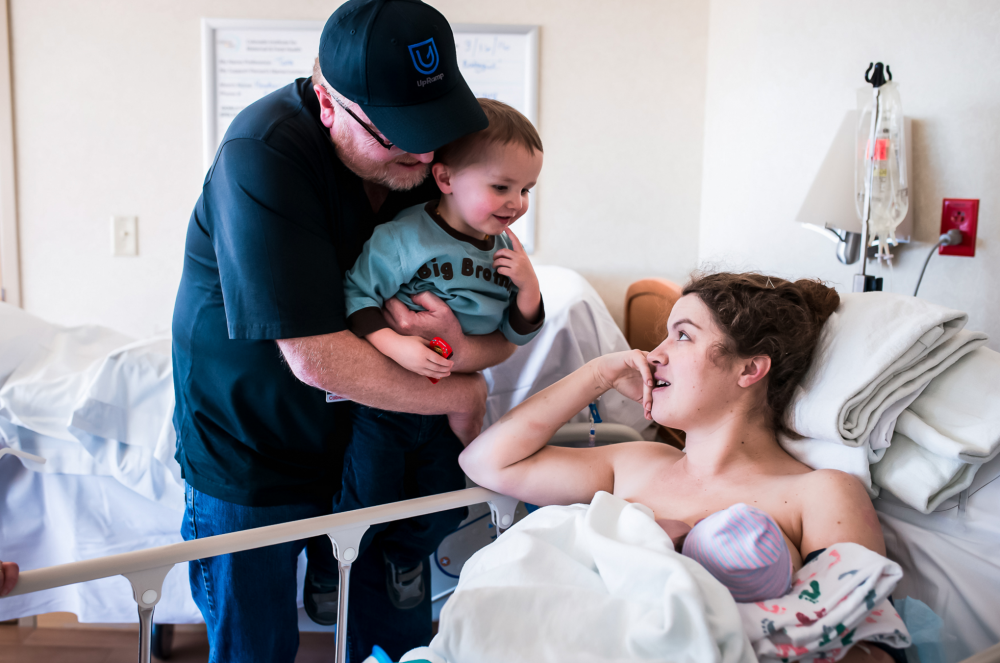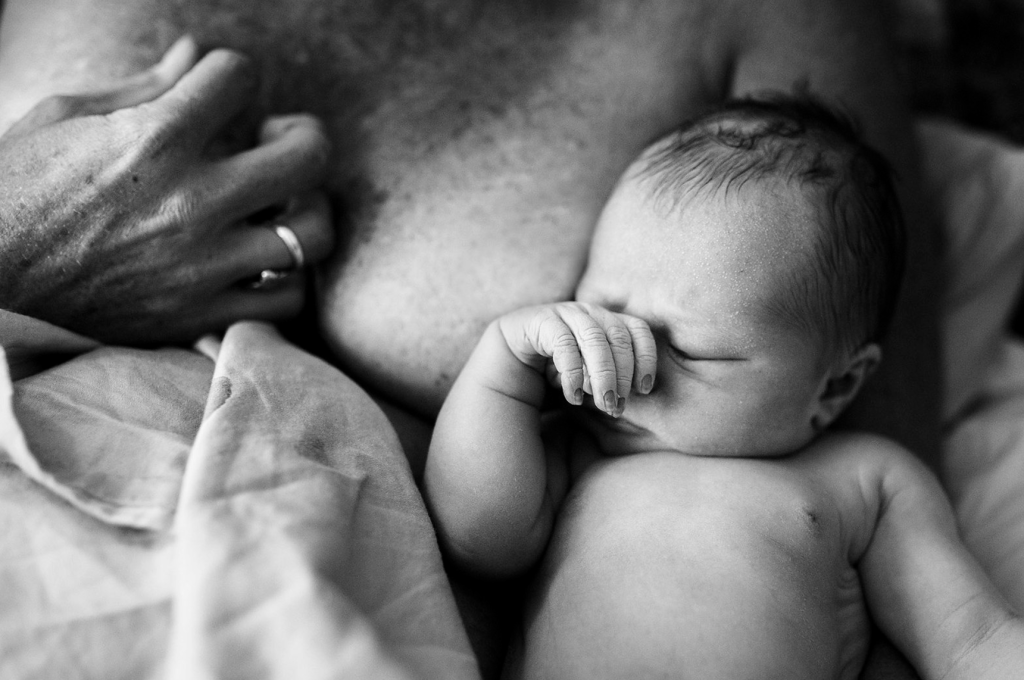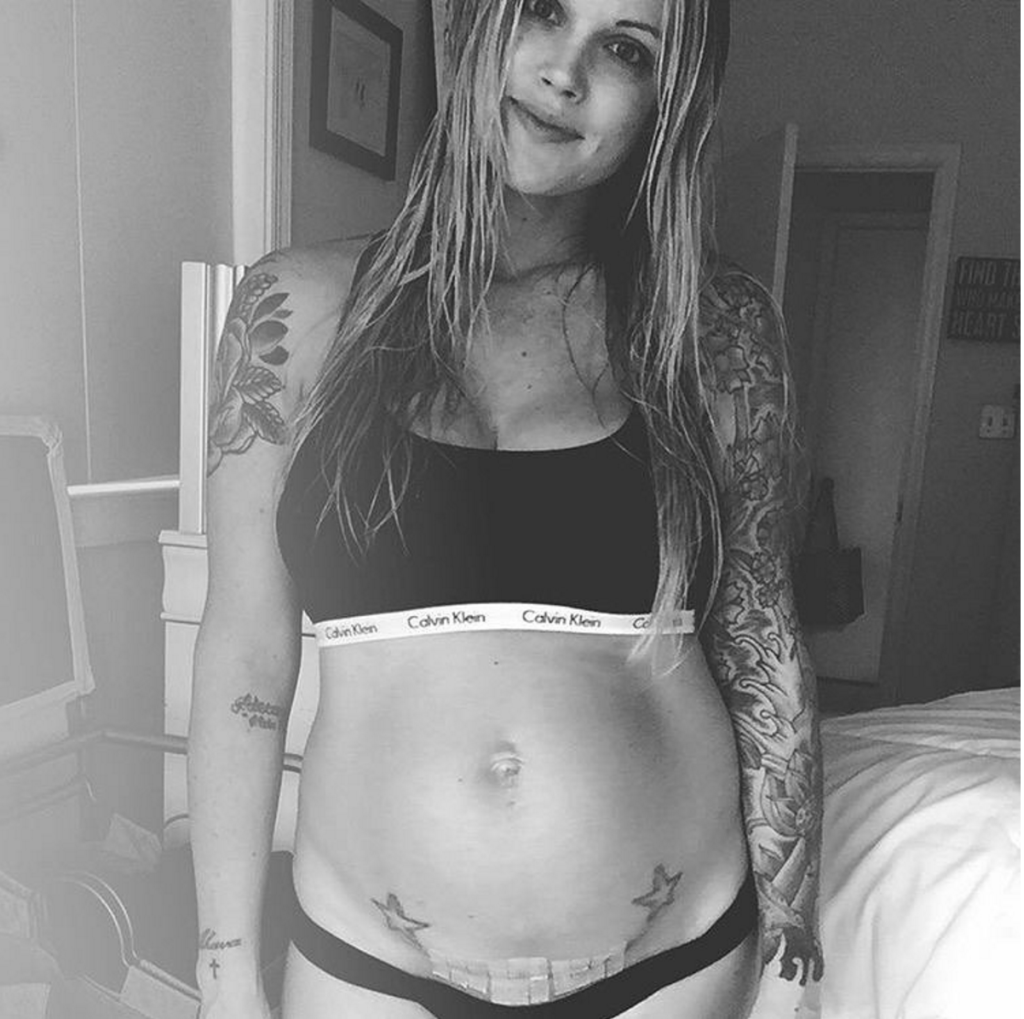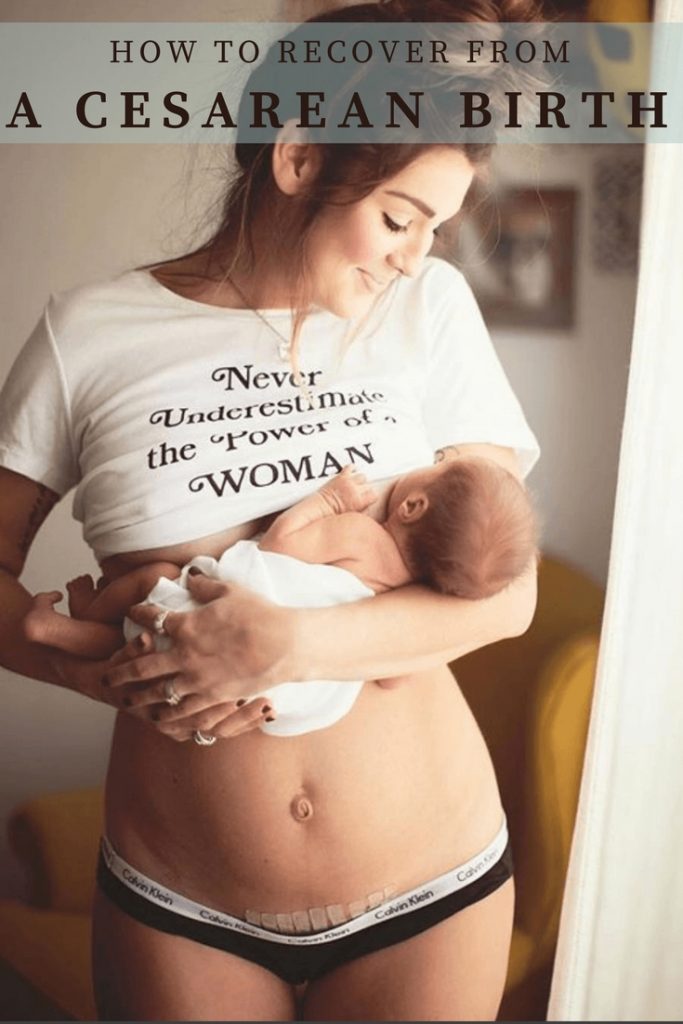Whether you have a planned or unexpected cesarean section birth, the recovery can present challenges for any woman and being prepared for certain possibilities can help relieve you of added stress. After all, this is major abdominal surgery affecting nearly one-third of women in the United States and even higher numbers in some other countries; c-section prep and recovery are definitely worth thinking about and planning for, no matter what kind of birth you have in mind.
In Hospital Cesarean Recovery
If you know ahead of time that you will have a c-section, here are some things to bring and what to expect of your stay after delivery.

What to bring to the hospital
Aside from your normal hospital bag, these few extra items might be helpful.
- Nice shampoo and lotion. Your favorite shower items can be a nice way to treat yourself.
- Clothing. Definitely do not pack anything restrictive that could cut into your incision area. Maternity pants, sweats, and robes are all good options. These high-waisted panties have great reviews for c-section comfort and a bit of support.
- High fiber snacks. Many women report some degree of GI pain and discomfort following surgery, and constipation is not uncommon. Having some fibrous foods on hand to eat during your stay can aid in normalizing your bowels. Pack some easy snack items to munch on between meals. Apples, oranges, pears, berries, nuts, and dried fruit are all good options. Remember to drink as much water as you can!
- Slip-free shoes. Slippers with rubber soles or flip flops will be handy when you go for laps around the floor and to the bathroom. It may be difficult to regain your balance post-surgery because you use all those core muscles that are currently on the mend. So make sure your shoes have good grip.
- Fabric wrap for your waist. Purchasing a belly band or bringing some stretchy fabric to wrap snugly around your waist can really help with added support when you are moving around post-surgery. Even coughs and sneezes can be quite jarring to your incision area, so having that core stabilization is nice. It also helps to encourage your abs to come back together after separation during pregnancy (diastasis recti). Holding a pillow tight around your stomach when coughing or sneezing can also help ease the pain, but having a wrap or belly binder allows you to have support and free up your hands for holding your new baby.
What to expect post surgery
Hospital policies vary but a three or four day stay is most common. Recommendations for getting up and walking will vary based on the type of anesthesia you were given as well as how your body responded to it, but it’s not uncommon for the staff to have you up and walking around after approximately 12 hours. If 12 hours post-op falls in the middle of the night they will probably keep the catheter that was placed for surgery inserted and wait until the next morning. Some hospitals don’t suggest getting up to walk until 24 hours following surgery. This is something to discuss with your doctor to decide what is the best course of action for you personally.
Mobility After Cesarean Birth
The reasoning behind getting you up and moving as soon as is safe is to encourage good blood flow to your extremities and prevent clots. Walking will also help with digestion, but will likely wear you out, so don’t overdo it. Taking a lap around the floor every couple of hours is probably sufficient.
While you’re still in the bed you’ll likely wear cuffs around your lower legs that occasionally pump up with air and squeeze tight. These compressions lower the risk of blood clots when you are less mobile.

Gastrointestinal Issues
Some women may feel very gassy and bloated. This can make it uncomfortable to try to pass gas as well as cause discomfort to your incision area where the muscles used for bowel movements are still healing from surgery. Answering questions about whether you’ve passed gas or had a bowel movement yet can be embarrassing but the staff needs to know your GI tract is back up and working to ensure you don’t have any complications there.
Your first bowel movement can be a nerve wracking event. The act of pushing can be painful to your healing muscles so you’ll be given stool softeners beginning right after surgery to help minimize the amount of pushing required. Many women report the anticipation of pain during a bowel movement was much worse than the actual pain experienced while some women do experience severe discomfort.
Anesthesia, surgery, narcotic pain relievers, and decreased mobility can all contribute to constipation so it’s important to take the stool softeners regularly, drink plenty of water, eat wholesome fiber rich foods, and be as mobile as your energy and pain level permits to help alleviate possible GI issues.
Uterine Recovery
Following all types of birth the uterus needs to contract in order to expel any remaining blood or tissue inside of it. Some women report no noticeable afterbirth pains (the uterine contractions that occur after baby is born), while others experience such strong ones that they equate them to labor pains.
Whether yours are mild or strong, they serve a purpose. It’s important for your uterus to begin the process of shrinking back down to its pre-pregnancy size. The nurses will need to assess the size and firmness of your uterus but palpating your abdomen. This is typically a fairly uncomfortable assessment whether you’ve had a cesarean or vaginal delivery. They have to press down hard to accurately assess the size of your uterus as well as how firm it is.
A shrinking, firm uterus is what they are looking for, whereas a ‘boggy’ uterus could indicate a problem requiring medication to help it contract more. The act of pressing down on it through your abdomen can help it along as well, and while they don’t usually have to press down very long it can be painful. The nurses will use this time to assess your level of bleeding as well. We recommend this afterbirth tincture.
Postpartum Bleeding
Many women are surprised to learn that following a c-section you will still have very heavy vaginal bleeding, just like vaginal deliveries. This lasts for about 4-6 weeks and the protocol is the same—no tampons allowed, only big absorbent pads. Your caregiver will likely provide some large mesh disposable underwear to use after delivery. These are a great option for the first few days following birth as they typically don’t irritate your incision site or put any pressure on that area the way some underwear elastic can—basically they are glorious! Stocking up on these as well as large overnight pads (these are our favorites) is a good idea since you’ll be changing them frequently the first couple of weeks.
Passing some heavy clots is fairly normal. The rule of thumb is generally if you pass a clot smaller than your fist, it’s okay. Anything larger—call your doctor.

Cesarean Incision care
Following surgery, your incision will be covered with a bandage that usually isn’t removed until the next day. Your incision will either be closed with sutures (dissolvable or non-dissolvable), staples, steri strips, or surgical glue on your abdomen. Staples and some types of sutures will need to be removed by your doctor a few days after you’re discharged. Before being discharged you will be given incision care instructions specific to your type of closure.
Keep in mind that your incision will look very different immediately after surgery than it will eventually. Most incisions will shrink down considerably and flatten to a thin line. Itching and tenderness around your incision is normal but annoying, anything more severe than that would warrant a call to your doctor. Try this spray or salve for expedited healing and scar reducing.
Advocate for Yourself at the Hospital and Home
Recovering from surgery, adjusting to new motherhood, getting the hang of breastfeeding—the first few days after a cesarean can be stressful and overwhelming. It’s important to make your needs known to the staff. If they don’t know your wishes, they can’t follow them. It’s your job to advocate for yourself and your new baby. Be open and clear with the hospital staff and expect the same from them—you’ll both benefit from respectful and clear communication. Never be afraid to request a new nurse if you aren’t receiving the care you feel you need or even if your personalities are not meshing well.
You never get the first few days with your new baby back again and they’re too precious to have marred by having someone around who puts you on edge, this goes for visitors and family as well. While well meaning and excited for you, visitors and family often end up putting more strain on mom than support. If friends want to come see the new baby make them earn the visit! Have them hold the baby while you take a shower or nap. Fold a basket of laundry while you chat. Fix some lunch or start a freezer meal in the oven for you. Have older kids? Ask friends to take them to the park for a hour and let them peek at baby when the come to pick them up.
You might be surprised at how eager people are to help when given specific tasks! But if the thought of a house full of people fills you with dread then don’t put yourself through it. Ask your partner or a supportive family member or friend to spread the word that you aren’t ready for visitors yet but appreciate everyone’s well wishes and put a sign on the door with the same sentiments.

Breastfeeding after a Cesarean Section
The first few days, your breasts produce a nutrient-dense, antibody-rich yellow liquid called colostrum. Colostrum is nature’s first perfect food for baby and provides all the nutrition, immunity, and vitamins your baby needs. Colostrum usually transitions to mature breast milk within 2-6 days of delivery. It’s not unusual for milk production, or ‘coming in’, to be delayed following a cesarean due to the use of IV fluids and other medications such as Pitocin. Once this occurs your breasts will be much larger and you may experience some engorgement. The best remedy for the discomfort of engorgement is removal of milk from the breast by the baby. Your baby will signal the amount of milk she needs your breasts to make and your supply will normalize. There are wonderful breastfeeding resources to be found here.
Some women have no additional difficulties breastfeeding following a cesarean than after a vaginal delivery but some find positioning difficult while their incision area is still tender (we love this breastfeeding pillow for keeping off your incision). Utilize the lactation consultants at the hospital as much as you need them while there. It’s a great idea to have an outpatient lactation consultant’s contact info saved already prior to delivery in the event you need more assistance following discharge. Ask friends who have had fulfilling breastfeeding relationships with their children for references to check out before you’re home with a new baby, sleep deprived, and probably pretty emotional.
The International Cesarean Awareness Network has some great info available regarding breastfeeding after a cesarean that can be found here. Kellymom.com is a great breastfeeding resource website in general and wonderful article about breastfeeding after cesarean can be found here.
Recovery at home after Cesarean Birth

Bringing a new baby home is an exciting time for everyone, but don’t forget to take care of yourself as well. Your baby needs a cared for mother as much as she needs to be cared for herself. Accept offers of help! People love to feel useful but may not know how best to help or are hesitant to step on toes. Give them direction and don’t be afraid to set boundaries when it comes to having people over. Physically, you’ll need to take it easy for a while. It’s often recommended that you not to lift anything heavier than the baby or drive for 2 weeks. After that, follow your body’s cues and rest as much as possible.
The best way to encourage a speedy recovery is to allow your body the time it needs to heal. Rushing the process can result in setbacks that will only prolong it. Once you feel up to it, which will vary for every woman, light exercises like walking can be beneficial.
Medication After C Section Birth
The types of medications prescribed for pain will vary from doctor to doctor and patient to patient. Ask someone (like your partner) to keep track of what time you take your medications as trying to remember on a sleep deprived brain is probably not the best plan. Many people recommend taking the meds on a strict schedule the first few days regardless of whether you’re in enough pain to feel you need it yet. This is suggested to prevent the pain getting ahead of you and then having to wait for the meds to kick in. Some people prefer to begin a slow weaning process off of the meds sooner if they don’t like the way they feel on them.
Pay attention to your reaction to the meds and to your pain level and make the best decision for your body. Don’t hesitate to call a nurse or doctor if you are concerned about any symptoms. There are many post-surgery symptoms that while totally benign, can alarm you if you haven’t experienced them before. Reach out for information when you need to.
Some women report referred pain in their shoulder during recovery. Not all women experience it, and it seems to be worse for patients who had general anesthesia vs. spinal anesthesia. The pain is due to irritation of the diaphragm, and trapped gas. Anti-gas medication and walking will help. The more regular you can get with your bowels, the sooner the pain will subside.

Bed comfort for Cesarean Mamas
Keep that wrap handy for when you get in and out of bed, to help with support. Wrapping before you get up and lay down provides stability and a little bit of comfort. Feel free to even keep it on for a while so you don’t have to constantly adjust it. Some women find it difficult to get up from a flat lying position in bed. Roll on your side first and push up with your hands to prevent straining your abdominal muscles. If this is still too uncomfortable try putting several pillows behind your back and rest or sleep in a reclined position. Your pelvis will be working to get back in its pre-pregnancy position and can ache after delivery. Try sleeping with a special pillow between your knees and ankles to help alleviate some pressure.
Night Sweats
There are lots of hormonal changes that take place right after delivery, and your body is also getting rid of a lot of excess fluid it carried while pregnant as well as any intravenous fluids given before, during, and after surgery. All of these factors combined might have you waking up at night to find the bedding and your clothes completely soaked. For the first couple of weeks, some women sleep on an extra sheet folded in half, or a towel so they can remove it midway through the night to have clean linens beneath them. Others suggest having clean pajamas handy for a quick middle of the night change. Remember to keep drinking a lot of water. It sounds counter-intuitive to replace excess fluid you are losing through sweat, but remember how much water is going toward milk production, so it’s necessary to keep things functioning well, and restore balance.
Mobility After A Cesarean Birth
For some women, stairs prove to be tiring and awkward to navigate the first couple of weeks. If possible, you might consider setting things up at home so that all the supplies for baby and for yourself will be mostly on one floor. Then stay in that area most of the day minimizing the need to navigate the stairs repeatedly. For other women the lure of being in their own bed on the second floor is enough to make it worth it. Just don’t hesitate to ask for help going up and down, even just having someone walk along beside you can be reassuring.
Keep in mind that your center of gravity has drastically changed and your body is still adjusting to that as well as healing from surgery. It’s not uncommon to feel off balance and it’s better to have help nearby just in case. Consider having pillows handy on both floors should you need to squeeze one against your abdomen while coughing or sneezing. Plan to give yourself plenty of time to recover, should it happen sooner than you planned—it will be a pleasant surprise! Be gentle with yourself. All women are different. There is no ‘right’ amount of time for recovery. There are no hard and fast rules for a healing timeline. Listen to your body, introduce things slowly back into your routine, and ease into motherhood.

Emotional Recovery after Cesarean Birth
Take time to evaluate your feelings about your cesarean experience. Mothers with planned cesareans have the opportunity to consider this beforehand but may still find themselves overwhelmed with conflicting emotions after the fact. Mothers who had an unexpected cesarean may feel blindsided and it’s important to take stock of all of these emotions and know that they are all valid.
It’s ok to feel disappointed in the way your baby was born. If you had planned for or envisioned things going differently, it’s completely normal to be sad it didn’t work out that way. This does not take away from the love and joy you have for your child. You can be deliriously happy that they are here and still be upset about how they came. Birth trauma may sound like a dramatic way to describe it but it’s not uncommon for women to experience varying degrees of trauma after a cesarean birth whether it was planned or unexpected, or especially if it was an emergency situation.
Your Feelings Are Your Own
Birth is a highly emotional experience and any emotions you have towards your child’s birth are valid and you are not alone in feeling them. Perhaps your cesarean was calm, you felt respected, and things went smoothly—this is the hope for all women experiencing a cesarean. Many women feel at peace with their sections and might not understand why others are seemingly devastated by theirs. Other women are deeply saddened by having had a section and cannot fathom why someone would choose to have one unless necessary.
When speaking with other mothers or mothers-to-be, be respectful of others’ experiences and perceptions of their experiences. Just because you loved your c section doesn’t mean another woman is wrong for disliking hers. Just because you hated your experience doesn’t mean another woman is wrong for liking hers. Evaluate and process your own feelings towards your cesarean and reach out for help.
Find others who can be supportive of your journey of processing your cesarean. The International Cesarean Awareness Network provides support, education, and advocacy for women experiencing cesareans and interested in VBAC (vaginal birth after cesarean.) ICAN can be found online here as well as on Facebook and Instagram. They have local chapters across the world which can be located on their website. Many of their chapters have individual Facebook groups and hold in person meetings for support. Talking to other women who have experienced a cesarean is an invaluable resource for processing your experience as well as planning for a cesarean section or a VBAC.
Birth is hard. Birth is beautiful. Birth is transformative. Take the time to take care of yourself and be proud of what you’ve accomplished and experienced for your new baby.
This guest post was written by Austyn Smith and a very special thanks Laura Shawver and Elizabeth Quinn who provided lots of great information while writing this post.
Resources
- Hamilton BE, Martin JA, Osterman MJK, et al. Births: Final data for 2014. National vital statistics reports; vol 64 no 12. Hyattsville, MD: National Center for Health Statistics. 2015. https://www.cdc.gov/nchs/data/nvsr/nvsr64/nvsr64_12.pdf
- Althabe,Fernando; Belizán, José M.; Betrán, Ana P.; Gibbons, Luz; Lauer, Jeremy A.; Merialdi Mario. The Global Numbers and Costs of Additionally Needed and Unnecessary Caesarean Sections Performed per Year: Overuse as a Barrier to Universal Coverage. World Health Report. 2010; Background paper, 30. Health Systems Financing. World Health Organization. 2010. [January 22, 2017]. http://www.who.int/healthsystems/topics/financing/healthreport/30C-sectioncosts.pdf
- Basar, Birsen; Cift, Tayfur; Olmez, Fatma; Ustunyurt, Emin; Yilmaz, Canan. Shoulder Tip Pain After Cesarean Section. Journal of Clinical and Diagnostic Research. Ausust, 1, 2015 [January 22, 2017]. Bethesda MD: National Center for Biotechnology Information. https://www.ncbi.nlm.nih.gov/pmc/articles/PMC4576593/

No Comments yet!